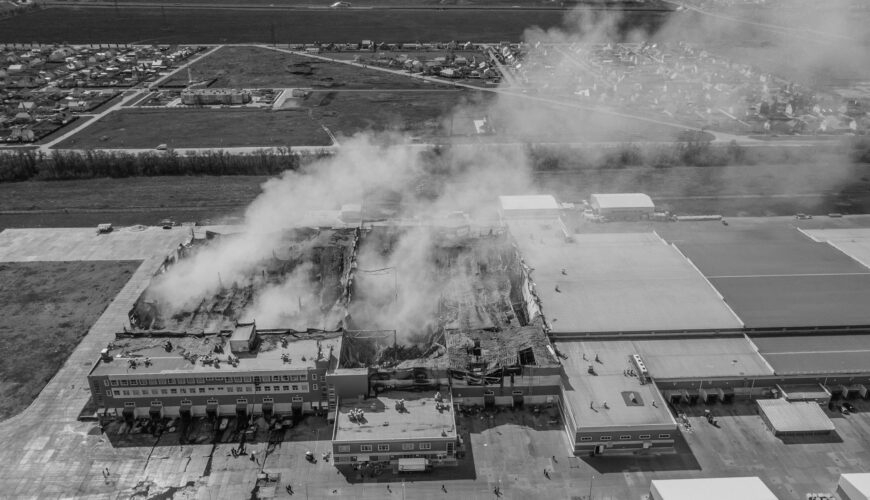Warehouse safety is essential for protecting personnel and assets. The bustling environment of these facilities, often characterized by the movement of goods, heavy machinery, and various hazards, necessitates a meticulous approach to safety management. A comprehensive framework guiding safety measures in these environments is provided by the National Fire Protection Association (NFPA).
5 Major Components of Warehouse Safety
Fire Protection Systems
Fire hazards pose significant risks in warehousing and distribution facilities due to the presence of combustible materials and high-density storage configurations. NFPA 13, Standard for the Installation of Sprinkler Systems, is the cornerstone for fire protection in these environments. It outlines requirements for designing, installing, and maintaining automatic sprinkler systems tailored to each facility’s unique characteristics.
Key considerations include proper spacing and coverage of sprinkler heads, adequate water supply, and compliance with local fire codes. Moreover, NFPA 25, Standard for the Inspection, Testing, and Maintenance of Water-Based Fire Protection Systems, mandates regular inspections and testing to ensure the reliability of fire suppression systems. Routine maintenance and prompt repairs are crucial to addressing potential issues and maintaining system integrity.
Beyond sprinkler systems, NFPA 72, the National Fire Alarm and Signaling Code, addresses installing and maintaining fire detection and alarm systems. Early detection of fire incidents can facilitate swift evacuation and intervention, mitigating potential catastrophic losses.
Electrical Safety
Electrical systems power essential equipment and machinery in warehousing and distribution facilities, but they pose significant hazards if not responsibly managed. NFPA 70, National Electrical Code (NEC), provides comprehensive guidelines for the safe installation and operation of electrical systems.
Proper grounding and bonding of electrical equipment, adherence to load capacities, and adequate clearance around electrical panels are among the critical requirements outlined in the NEC. Regular inspections of electrical systems, including wiring, outlets, and circuit breakers, are essential to identify and address potential hazards such as overheating, short circuits, and electrical faults.
Furthermore, NFPA 70E, Standard for Electrical Safety in the Workplace, focuses on safeguarding personnel against electrical hazards. It mandates the implementation of safety training programs, the use of personal protective equipment (PPE), and the establishment of procedures for working on energized equipment.
Building and Life Safety
The structural integrity of warehouse buildings and the implementation of life safety measures are paramount for protecting occupants during emergencies. NFPA 101, Life Safety Code, offers comprehensive guidance on various aspects of building design, construction, and occupancy to ensure the safety of occupants.
Key provisions include adequate means of egress, proper exit signage, and emergency lighting to facilitate swift evacuation during fire or other emergencies. Additionally, NFPA 13R, Standard for the Installation of Sprinkler Systems in Low-Rise Residential Occupancies, addresses fire protection requirements in low-rise storage facilities, incorporating provisions tailored to residential occupancies within warehouses.
Regular inspections and maintenance of building systems, including structural elements, fire doors, and exit stairwells, are essential to uphold life safety standards and mitigate risks.
Emergency Response
Effective emergency response procedures are essential for minimizing the impact of incidents and ensuring the safety of personnel and property. NFPA 1600, Standard on Disaster/Emergency Management and Business Continuity/Resilience Programs, provides a framework for developing comprehensive emergency response plans tailored to warehousing and distribution facilities’ unique needs.
Key components of emergency response planning include risk assessment, emergency notification systems, evacuation procedures, and coordination with local emergency services. Regular drills and exercises help familiarize personnel with emergency protocols and ensure a swift and coordinated response in real-world scenarios.
Industrial/Chemical Hazards
Warehousing and distribution operations often involve the handling and storing of hazardous materials, ranging from flammable liquids to corrosive substances. NFPA codes and standards, such as NFPA 400, Hazardous Materials Code, and NFPA 704, Standard System for the Identification of the Hazards of Materials for Emergency Response, provide guidelines for the safe storage, handling, and mitigation of chemical hazards.
Proper segregation of incompatible materials, adequate ventilation systems, and appropriate containment measures are essential for minimizing the risk of chemical incidents. Additionally, NFPA 30, Flammable and Combustible Liquids Code, establishes requirements for the safe storage and handling of flammable liquids, including installing secondary containment systems and using approved storage containers.
Warehouse safety is a multifaceted endeavor that requires adherence to rigorous standards and regulations outlined by NFPA. By implementing comprehensive fire protection systems, ensuring electrical safety, upholding building, and life safety standards, developing effective emergency response plans, and mitigating industrial/chemical hazards, organizations can create safer work environments for their personnel while safeguarding their assets against potential risks and disasters. Regular training, inspections, and collaboration with regulatory authorities are essential elements of a proactive safety management approach in these dynamic environments.
Designing warehousing and distribution systems, particularly high-density storage systems, is becoming increasingly complicated considering more stringent code requirements. OPSdesign works closely with regulatory/code compliance professionals internally and externally to design compliant processes, systems, infrastructure, and labor strategies.


